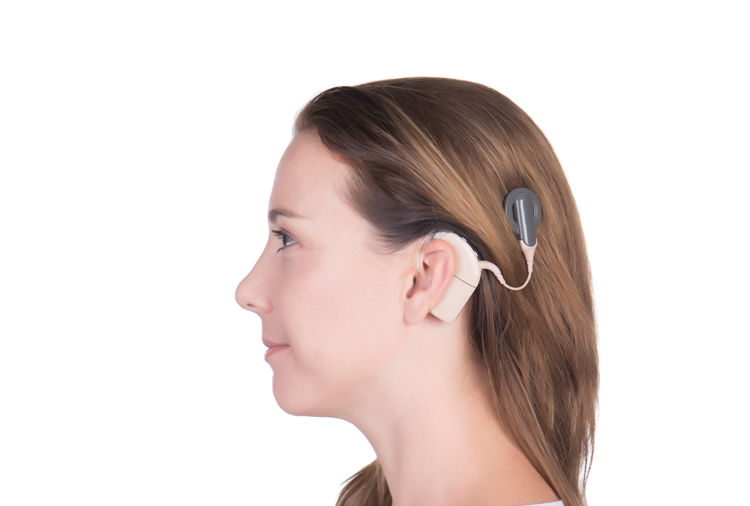
What is a cochlear implant?
A cochlear implant is a ultra-miniature device that improve hearing (sound perception of speech and environmental noises) in people with severe to profound deafness. Unlike hearing aids, these devices stimulate the cochlea directly through surgically implanted electrodes.
Anatomy of a cochlear implant
A cochlear implant has two parts: internal and external. The internal part is inserted under the skin behind the ear in a surgical procedure requiring general anesthesia. The external part has a sound processor that’s linked to an antenna. The antenna contains a magnet that holds it to the internal part, which also creates the vital contact between the implant’s two sections. The sound processor might be a small box or worn behind the ear, which works either with or without a remote control.
How does it work ?
- The microphone captures the sounds in the environment, which are then analyzed and coded by the processor.
- The coded sounds are sent to the implant’s internal part where they are converted into electric pulses.
- The electric pulses are sent to the electrodes.
- The electrodes stimulate the hearing nerve, which sends the information to the brain.
How is a cochlear implant inserted ?
The implantation requires a very detailed surgery of about two hours. The surgeon makes a small incision behind the ear, then piercing a hole in the bone to reach the middle ear. Next, a tiny one millimetre hole is made in the cochlea’s round window where the electrode array will be inserted. Like any other surgery, there are general risks of hemorrhage or infection. There are also more specific risks, such as facial paralysis, because the facial nerve is very close to where the cochlear implant surgery is done. This risk however is extremely slim. Recovery from the implant surgery takes about four to six weeks.
Activating and programming the implant
After the surgery, it takes a few weeks of waiting before hearing can occur. The cochlear implant must be activated and programmed so the patient can hear again. Before activating the device, the audiologist gradually increases the amount of current in the implant to help the patient get used to it and eventually hear at an acceptable volume. This programming takes 10 days, at most.
To patients’ great surprise, sounds may be heard differently once the implant is activated. This is a normal part of the process. Early on, the person might hear beeps, or a voice might sound like Mickey Mouse. Others might hear voices normally right away. As much as the first results differ from person to person, so do the emotions: some laugh, some cry. People react in their own ways.
Adapting to a new way of hearing with a cochlear implant
The adaptation period follows activation and programming. During this time, the brain will learn, or relearn, how to decode the sounds captured by the cochlear implant. And sounds may seem different than how they were heard before. Sometimes this causes confusion, like when a person thinks he’s/she’s hearing a plane overhead when it’s really the neighbour’s lawnmower.
Intensive rehabilitation sessions take place over 10 weeks, although the time period varies between patients. Some people only need six weeks, while others might need up to twice that time. The final results vary too: some people are able to hear another person speak without seeing his/her face, while others still lean on lip reading to help them understand speech.
It’s important to realize that anyone who has had the surgery still has hearing loss. The implant might improve the perception of speech and other environmental sounds, but some quiet sounds may still be inaudible. The implant helps hear quiet sounds, but it cannot analyze those sounds like a normal ear would. So it is still harder for someone with a cochlear implant to understand speech than someone with normal hearing. Understanding speech in noisy surroundings is still not an optimal situation even with an implant, and the wearer’s perception of music might be different as well.
On May 17, 1984, otolaryngologist Dr. Pierre Ferron did the first surgery to insert a cochlear implant at the Hôtel-Dieu de Québec hospital. Since then, more than 2,000 implants have been fitted on people of all ages, the youngest being four months old, and the oldest being 90.
For more informations, do not hesitate to make an appointment with an ENT doctor.
Note: CHU de Québec-Université Laval is the only hospital in Quebec to perform surgeries for the cochlear implant.

